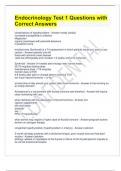Endocrinology Test 1 Questions with
Correct Answers
complications of hypothyroidism - Answer-mostly cardiac
increased susceptibility to infection
Megacolon
organic psychoses with paranoid delusions
myxedema coma
levothyroxine (Synthroid) is a T4 replacement in which patients would you want to use
caution - Answer-patients over 60
those with ischemic heart disease
-start low 25mcg/daily and increase 1-3 weeks until pt is euthyroid
Synthroid - Answer-3-4 weeks after therapy near normal levels
25-75 mcg/day starting dose
maintainance dose ~175 mcg/day
monitor dose w/TSH
6-8 weeks after start or change before checking TSH
too much thyroid hormone -> a-fib
at what time of day should your patient take throid hormone - Answer-in the morning on
an empty stomach
Amiodarone is a concomitant with thyroid hormone and therefore - Answer-will require
close monitoring with use
what interferes with the absorption of thyroid hormone - Answer-iron
calcium supplements
bile acid resins
antacids
soy
PPI's (T4 specifically)
what women may require a higher dose of thyroid hormone - Answer-pregnant women
women on estrogen therapy
congenital hypothyroidism (hypothyroidism in infancy) - Answer-cretinism
5 month old baby presents with a thickened tongue, poor muscle tone and has deaf-
mutism - Answer-cretinism
etiology: aplasia or hypoplasia of the thyroid or failure of the thyroid gland to migrate to
its normal anatomical location
,childhood (acquired) hypothyroidism is usually from - Answer-Hashimoto's thyroiditis
TSH insufficiency - Answer-secondary hypothyroidism
causes of secondary hypothyroidism - Answer-pituitary tumor
pituitary hemorrhage
pituitary infection
what labs can you expect in secondary hypothyroidism - Answer-serum TSH is low or
low normal
T4 is at the lower limit of normal
TRH will be elevated - this will increase prolactin levels as well
this rare but severe and life threatening hypothyroid condition is more common in older
women who have had a stroke or stopped taking medication (they usually have a
history of hypothyroidism, often poorly controlled) - Answer-Myxedema Coma (crisis)
factors that precipitate myxedema coma - Answer-sepsis
exposure to cold
central nervous system depression
trauma
you have a bradycardic with an altered mental status, weakness, they are hypothermic
and hypoventilating w/hypoxia and hypercapnia. They also have hypotension,
hyponatremia, and hypoglycemia - Answer-clinical presentations of Myxedema coma
management of the myxedema patient - Answer-intubation and mechanical ventilation
blankets only for hypothermia
IV fluids for volume expansion (hypertonic saline for hyponatremia)
Synthroid
corticosteriods IV for adrenal insufficiency
extreme hyperthyroidism /thyrotoxicosis is also known as - Answer-thyroid storm
high mortality rate
rare, but when it occurs it's often in patients with Grave's Disease
thyroid storm precipitating factors - Answer-Stressful illness
Thyroid surgery
Radioactive iodine administration
Discontinuing anti-thyroid drugs
pt presents with:
Marked delirium, Severe tachycardia or atrial fibrillation, Vomiting, Diarrhea,
Dehydration
, Very high fever - hyperpyrexia out of proportion to other clinical findings is the hallmark
of thyroid storm ( > 103), Sweating, tremors, restlessness
you suspect - Answer-THYROID STORM
treatment of the patient with Thyroid Storm - Answer-Admit to ICU
Anti-thyroid drugs, potassium iodide, Inderal (propanolol), hydrocortisone
Definitive treatment: 131I ablation or surgery
these hormones are synthesized in the adrenal cortex - Answer-Glucocorticoid
hormones: Cortisol
Mineralocorticoids: Aldosterone
Androgens:
Dehydroepiandrosterone (DHEA) and dehydroepiandrosterone sulfate (DHEAS)
Testosterone and androstenedione
the inner medulla of the adrenal glands is - Answer-Extension of sympathetic nervous
system
~Catecholamines
Corticotropin-releasing hormone (CRH) is produced in the hypothalamus and stimulates
_____ - Answer-ACTH synthesis
Corticotropin-releasing hormone (CRH) is produced in the hypothalamus and is
inhibited by_____ - Answer-cortisol (via negative feedback)
features of polypeptide/protein hormones - Answer-large >500kDa
hydrophilic
circulate unbound
Serum T1/2 = minutes
receptors on cell surfaces
second messengers that alter activity of other molecules within cells
examples of polypeptide/protein hormones - Answer-LH, FSH, catecholamines, ACTH,
TSH, prolactin, GH, GHRH, CRH, GnRH, AVP, PTH, VIP, glucagon, insulin,
somatostatin, IGF-I
features of steroid/thyronine hormones - Answer-small <500kDa
hydrophobic
circulate bound to proteins
serum T1/2 = hours
receptors are located in the cytoplasm and nucleus
have direct nuclear action
examples of steroid hormones - Answer-testosterone, E2 (estrogen), progesterone, T4,
T3, cortisol, aldosterone, vitamin D, thyroxine




